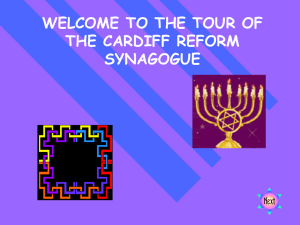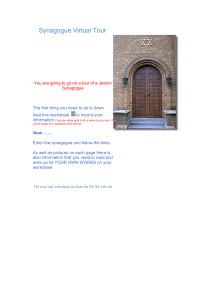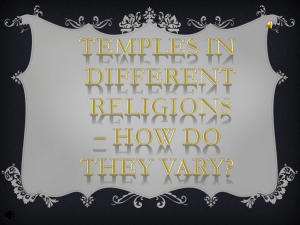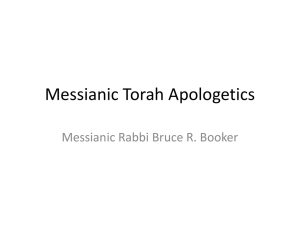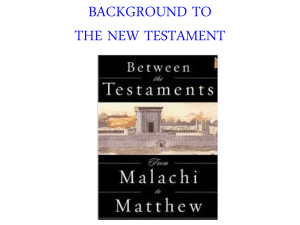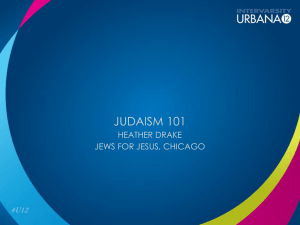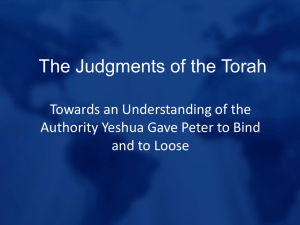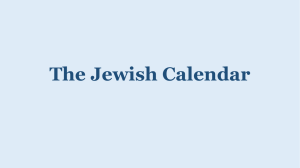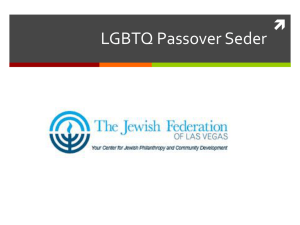SYNAGOGUE SERVICES and BELIEFS in JUDAISM
advertisement
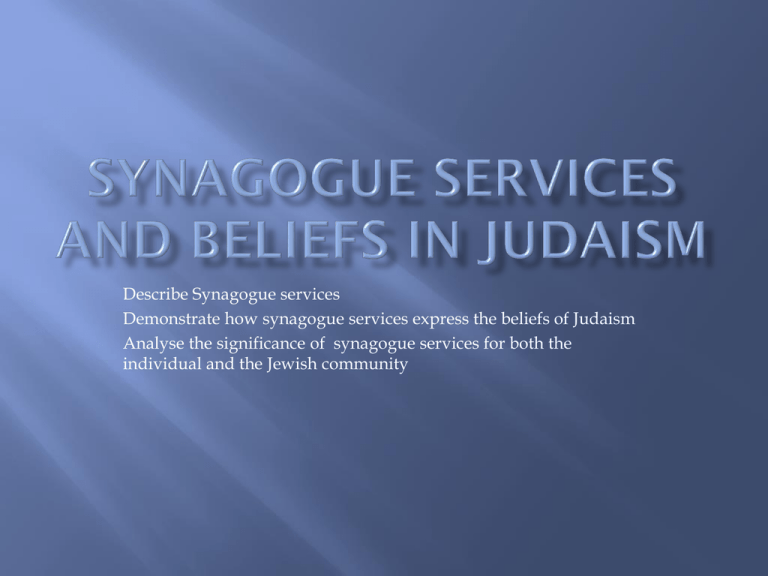
Describe Synagogue services Demonstrate how synagogue services express the beliefs of Judaism Analyse the significance of synagogue services for both the individual and the Jewish community Adult males (and boys who have made their Bar Mitzvah) are required to attend the synagogue regularly. It is up to the person to fulfil this requirement as well as they can. Women do attend synagogue services but this is not a religious requirement for women, whose primary responsibility is recognised as running a good Jewish home. Synagogues services are held every day, with some differences in the services. Sabbath day services are important. There are three services held each day. Jews also attend synagogue services on High Holy Days, festivals and fasting times, weddings, funerals, Bar and Bat Mitzvahs. Jews also attend educational and social events at the synagogue. The word ‘synagogue’ is a Greek translation of the Hebrew ‘Beit Knesset’ meaning ‘House of Assembly’. This term highlights the Jewish belief that their religion is a communal religion. This sense of the communal nature of the religion is linked to Jews understanding of themselves as the people of God, bound to Him by the Covenant. The synagogue is the social, intellectual and spiritual centre of the life of the Jewish community. All synagogues have services three times a day.Shacharit in the morning, Minchah in the afternoon and Ma’ariv in the evening. There is an additional service – the Musaf – after the morning service on the Sabbath and on fasts and festivals and on Monday and Thursday morning. Jewish prayers are usually recited in Hebrew. In Progressive services, much of the language used, is the language of the country of the people, for example English in Australia. Members of the congregation use a book called a siddur to follow the order of the service. Men wear a fringed prayer shawl at morning services in obedience to the Biblical commandment to remind themselves of the Divine. Reform services follow the same structure as Orthodox services but shorter and with some changes in content. The service begins and ends with the singing of Hebrew poetry rejoicing in the attributes of God. This affirms and celebrates Jewish beliefs about God. Services include several Blessings in praise of God throughout the service. Psalms are recited or sung. A central point of the service is the recitation of the Shema (Hear) This belief is expressed in the recitation of the Shema, a central feature of every synagogue service. “Hear O Israel, The Lord our God. The Lord is One. Blessed be his name, whose glorious kingdom is for ever and ever. And you shall love the Lord your God with all your heart and with all your soul and with all your might.” Deut. 6:4-9 God is One •God is pure spirit •All powerful •Merciful and Just The Amidah a prayer which praises God as all powerful and merciful. This is a silent standing prayer also known as the ‘Eighteen Blessings.’ After the personal recitation, the Amidah is repeated as a chant by the reader and then the congregation repeat , “Holy, holy, holy is the Lord of hosts: the whole world is full of His glory.” Jews believe that the Torah is the word of God, given to them as a source of inspiration, reflection and moral guidance. The Torah is read in the synagogue Sabbath morning service and the reading is performed with great ceremony which highlights Jewish belief in the central importance of the Torah. The Torah is also read at the morning service at synagogue on Monday and Thursday. The Torah scrolls are housed in the Ark which stands at the Jerusalem end of the synagogue. The members of the congregation are able to see the Ark. Above the Ark are the words “Know before Whom you Stand.” These words reflect the belief that God is experienced in the words of the Torah. In front of the Ark hangs an eternal light, in memory of the eternal light in the Temple. The central location and architectural significance given to the Ark, reflects the belief that God gave the Torah to Moses and that the Torah was housed in the Ark of the Covenant in the temple in Jerusalem. This symbolic positioning of the Torah scrolls reminds Jews of their history and their continuation in this Covenant with God. The reading from Torah is an essential element of the Sabbath morning service. The Torah scrolls are taken from the Ark and paraded before the congregation in a procession around the synagogue. Members of the congregation will touch or kiss the Torah as a mark of respect and veneration, highlighting the belief in the importance of the Torah. The congregation stand during this procession. In Orthodox synagogues where women are seated separately, they will stretch out their hand towards the Torah and kiss their hand. The scroll will be taken to the Bimah and the reading will take place, with the reader facing the Ark. The Torah scrolls are then returned ceremoniously to the Ark, accompanied by another psalm. There will be a reading from the Prophets. Thiis is known as Haftarah. Aleinu silent standing prayer of praise for God at the end of every service. There is usually a sermon at this time. This will be a commentary drawing moral lessons from the Torah or Haftarah reading. The Amidah is repeated with appropriate additions for the day. The Kaddish prayer is read, recalling the rituals of the Temple. Hymns celebrating God. After the Sabbath service the Kiddush blessing over wine is held in the synagogue hall. The ‘Days of Awe’ - The ten High Holy Days of Rosh Hashanah leading to Yom Kippur is an important time in the synagogue. The shofar is blown to mark the beginning of the liturgical period, when Jews reflect on themes of judgement and repentance. One of the most memorable prayers is recited at this time ‘Avinu Malkynu’ “Our Father, our King” this shows Jewish belief about the power and mercy of God. Yom Kippur services run throughout most of the day in the synagogue, beginning with the morning service, Shacharit and ending with Ne’ilah referring to the symbolic closing of heaven’s gates and the ‘book of life.’ The Havdalah ceremony ends this holiday. Rabbis and cantors wear white on Yom Kippur to symbolise purity and the belief that God shall make sins as white as snow. The communal confession of the congregation– the Vidui – emphasises Jewish belief in communal responsibility for sins. 1. Judaism is a religion which emphasises living out belief in God rather than focusing on the ‘articles of faith’. Nevertheless there are clear links between what takes place in synagogue services and beliefs in Judaism. Belief in One God who made the universe and is all powerful. This is reflected in the many beautiful prayers, Blessings and psalms found in synagogue services. The Shema is a key example of how prayers demonstrate belief in God. 2. The Torah is the word of God and provides spiritual inspiration as well as ethical guidelines for ‘living Judaism.’ Living by these commandments enacts the continuing Covenant between God and the Jewish people. This belief is seen in the central importance given to the Torah scrolls in the internal design of the synagogue and the procession and reading from the Torah in the Sabbath, Monday and Thursday services. Men who attend synagogue services wear prayer shawl as instructed by the commandment in the Torah to remind themselves of the Divine by wearing fringes at the corner of their garments. 3. The spiritual and historical importance of Jerusalem and Israel. This is seen in the placement of the Ark containing the Torah scrolls in the direction of Jerusalem. Jews recall the Covenant with God, the Temple and the original Ark of the Covenant which was there.
